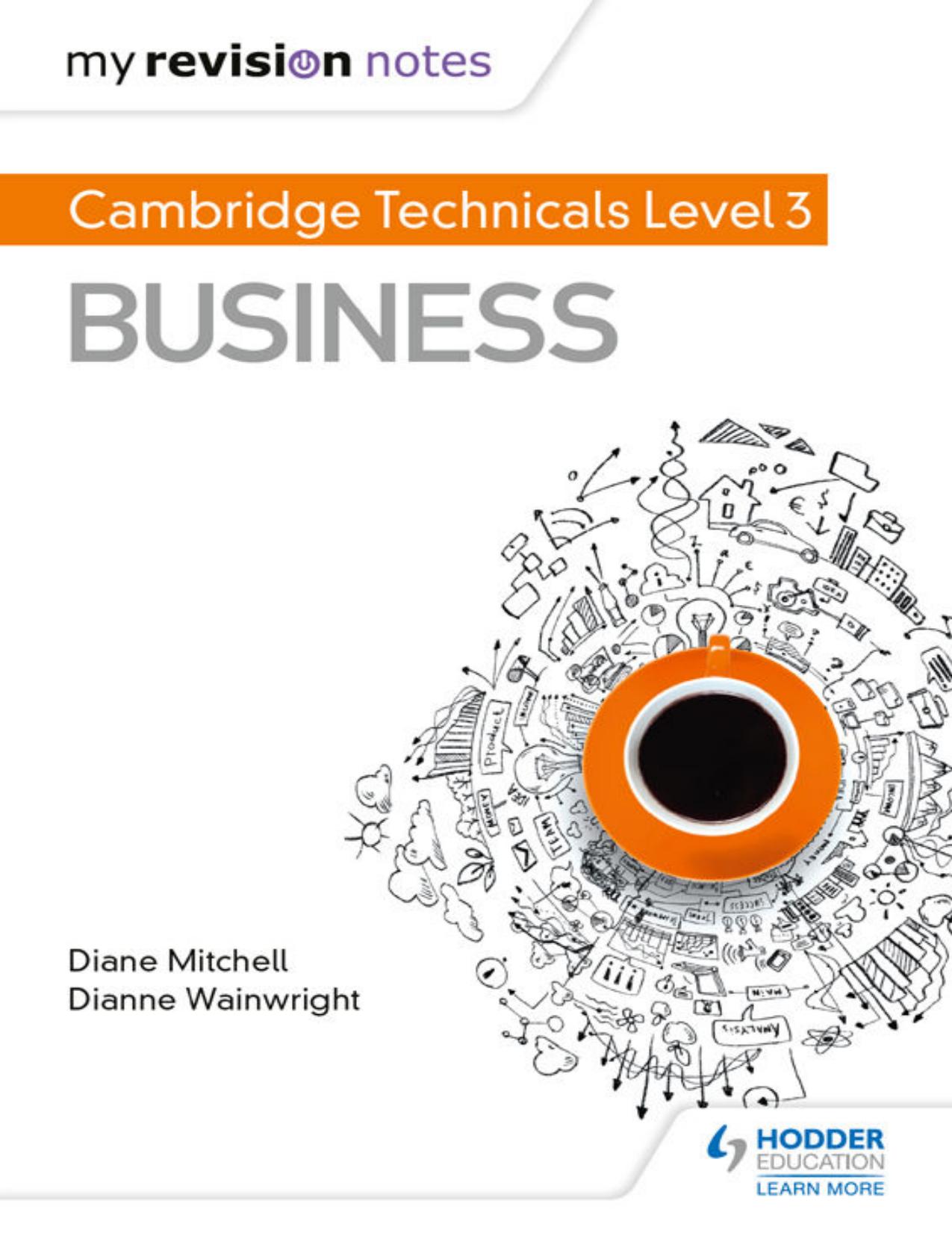My Revision Notes Cambridge Technicals Level 3 Business 1st Edition by Dianne Wainwright, Diane Mitchell ISBN 9781510442252 1510442251
$70.00 Original price was: $70.00.$35.00Current price is: $35.00.
Instant download My Revision Notes Cambridge Technicals Level 3 Business Dianne Wainwright & Diane Mitchell after payment
My Revision Notes Cambridge Technicals Level 3 Business 1st Edition by Dianne Wainwright, Diane Mitchell – Ebook PDF Instant Download/Delivery: 9781510442252 ,1510442251
Full dowload My Revision Notes Cambridge Technicals Level 3 Business 1st Edition after payment

Product details:
ISBN 10: 1510442251
ISBN 13: 9781510442252
Author: Dianne Wainwright, Diane Mitchell
Target success in Cambridge Technical Level 3 Business with this proven formula for effective, structured revision. Key content coverage is combined with exam-style tasks and practical tips to create a revision guide that students can rely on to review, strengthen and test their knowledge. With My Revision Notes, every student can: – plan and manage a successful revision programme using the topic-by-topic planner – consolidate subject knowledge by working through clear and focused content coverage – test understanding and identify areas for improvement with regular ‘Now Test Yourself’ tasks and answers – improve exam technique through practice questions, expert tips and examples of typical mistakes to avoid – get exam ready with extra quick quizzes and answers to the practice questions available online.
My Revision Notes Cambridge Technicals Level 3 Business 1st Edition Table of contents:
Unit 1 The business environment
1 Understand different types of businesses and their objectives
1.1 Different types of business activity
1.2 Different sectors of operation
1.3 Different forms of legal business ownership
1.4 Factors which inform business ownership
1.5 Differing business aims and objectives
2 Understand how the functional areas of businesses work together to support the activities of businesses
2.1 Key tasks of functional areas of businesses
2.2 How business functions interrelate with other business functions
3 Understand the effect of different organisational structures on how businesses operate
3.1 Different organisational structures
3.2 Elements of organisational structures
3.3 How the elements of organisational structures impact on business operations
3.4 The use of organisation charts
4 Be able to use financial information to check the financial health of businesses
4.1 Definitions of financial terms
4.2 How to calculate profit/loss and break-even
4.3 How to interpret financial statements
5 Understand the relationship between businesses and stakeholders
5.1 Who the main stakeholders are and their objectives
5.2 The ways in which different stakeholder groups attempt to alter business behaviour
5.3 How businesses respond to the different and sometimes conflicting objectives of different stakeholders
5.4 The consequences to a business of not listening to its stakeholders
6 Understand the external influences and constraints on businesses and how businesses could respond
6.1 The factors which comprise the external business environment
6.2 How the external environment can impact on a business and its stakeholders
6.3 How businesses can respond to changes in their external environment
7 Understand why businesses plan
7.1 Why businesses plan
7.2 To determine appropriate sources of finance for businesses
7.3 What may be included in a business plan
8 Be able to assess the performance of businesses to inform future business activities
8.1 Factors affecting the success/failure of a business
8.2 How to conduct a SWOT (strengths, weaknesses, opportunities and threats) analysis
8.3 How to interpret business performance
Unit 2 Working in business
1 Understand protocols to be followed when working in business
1.1 The authority protocols
1.2 The confidentiality protocols
1.3 The constraints on document content
1.4 The checking protocols
1.5 The IT security protocols
1.6 The employment protocols
2 Understand factors that influence the arrangement of business meetings
2.1 The factors that influence meeting arrangements
2.2 The factors that influence business travel arrangements
2.3 The factors that influence business accommodation arrangements
3 Be able to use business documents
3.1 The purpose, interpretation and completion of business documents
3.2 The purpose and interpretation of other business documents
3.3 How to make payments and the advantages and disadvantages of each payment method
3.4 The purpose, completion and checking of meeting documentation
4 Be able to prioritise business tasks
4.1 The reasons for prioritising business tasks
4.2 The factors that influence task prioritisation
4.3 How to use information to inform prioritisation
4.4 How to assign priorities and identify appropriate actions to complete tasks in accordance with their priority
4.5 The need to change priorities when necessary
5 Understand how to communicate effectively with stakeholders
5.1 The characteristics which inform the design of business communications
5.2 How the design characteristics of business communications impact on the use of resources
5.3 How and when to use different types of communication
5.4 How to review business communications to make sure they are fit for purpose
Unit 3 Business decisions
1 Understand factors to be taken into account when making business decisions
1.1 Different types of business decision
1.2 Different criteria used when making business decisions
1.3 The use of different types of information when making business decisions
1.4 How to judge the validity of information used to make decisions
1.5 The purposes, benefits and importance of communication
1.6 Factors affecting the quality of decision making
2 Be able to use financial data to inform business decisions
2.1 How to use profitability data
2.2 How to use break-even analysis
2.3 How to use contribution data
2.4 How to use cash flow data
2.5 How to use investment appraisal
3 Understand how human resource information informs business decisions
3.1 Factors involved in workforce planning
3.2 How to use workforce performance data
4 Understand how marketing information informs business decisions
4.1 How to use market research information
4.2 How to use marketing decision-making tools
4.3 Considerations when making marketing decisions
4.4 How constraints on marketing impact business decisions
5 Be able to use resource, project and change management information to inform business decisions
5.1 The issues and key tasks involved in resource management
5.2 How to use project management tools
5.3 How to use and interpret critical path analysis (CPA)
5.4 How change is managed
5.5 The factors involved in contingency planning
6 Be able to use information to make and justify business decisions
6.1 How to use business decision-making tools
6.2 How different strategies are used to help a business achieve a competitive advantage in different circumstances
6.3 How to make business decisions
6.4 How to justify a business decision
Unit 4 Change management
1 Understand the drivers of change
1.1 Drivers of change
2 Understand the key aspects of theories of change management
2.1 Theories of change management
3 Be able to plan for change, manage change and overcome barriers
3.1 Ways to plan for and manage change
3.2 Possible barriers to change
4 Be able to assess the impacts of change on businesses and stakeholders
4.1 Possible impacts of change on businesses
4.2 Possible impacts of change on stakeholder groups
5 Be able to use data to monitor change management in businesses
5.1 Different types of data used to monitor the change management process
5.2 The need for continual monitoring of the change management process against the original objectives and plan
Glossary
People also search for My Revision Notes Cambridge Technicals Level 3 Business 1st Edition:
cambridge technicals level 3 results day
cambridge technicals results
can you retake btec level 3
my revision notes cambridge technicals level 3 business
highest btec level 3 grade


